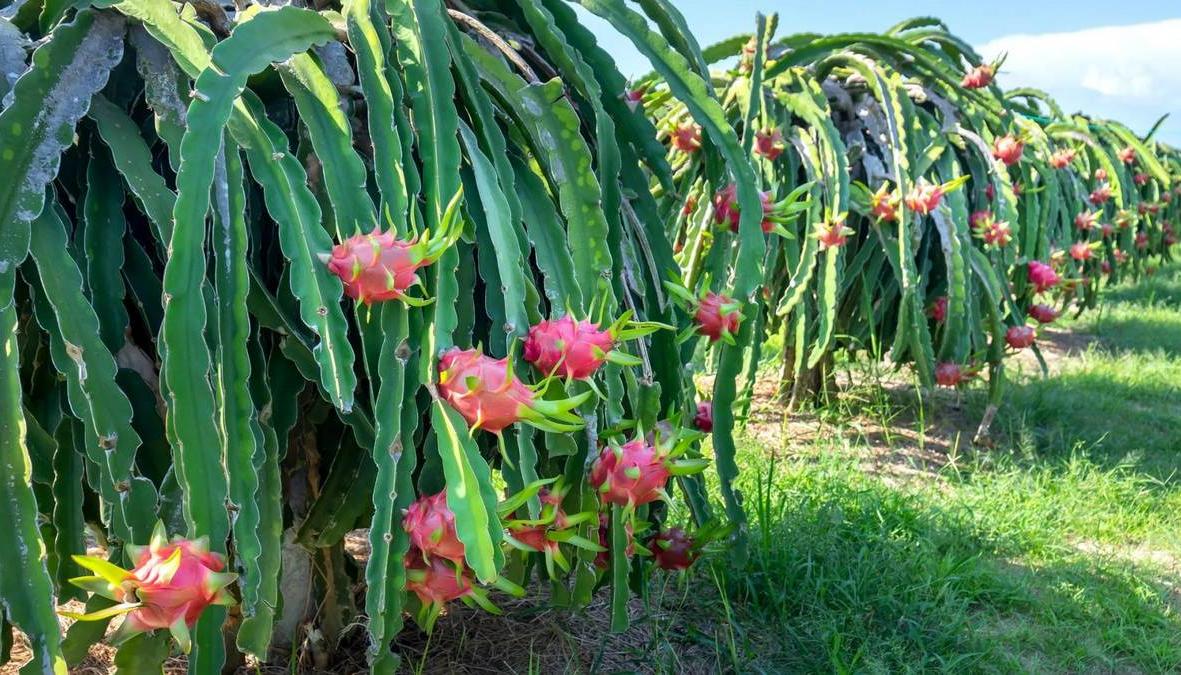As Aztec literature indicates, the dragon fruit would have been discovered around the 13th century. The plant from which the dragon fruit comes is a type of cactus from the Hylocereus family , which also bears the name "queen of the night", precisely because the dragon fruit blooms only at night. You can also meet this fruit under the name "pitaya" or "pitahaya", and its taste is usually described as a combination between the taste of kiwi and the taste of pear.
The dragon fruit has a distinct appearance, it is sweet, crunchy and at first glance it may seem like a rather unusual fruit. However, it can be easily grown in your own garden. Initially, it was very widespread in Latin America and Southeast Asia, but today it has become popular in all parts of the world. Besides the splash of color it brings to your garden, this fruit can be enjoyed in many ways, being famous for its rich fiber and antioxidant content. If we have caught your attention, continue reading to find out how you can grow dragon fruit at home and what conditions are necessary to grow the plant that produces it.
If you like to grow your own fruits and take care of plants , you will definitely succeed in growing dragon fruit. With a size of 10-15 cm (4 - inch) and a weight of 220-350 grams (0.5 - 0.8 lbs), the dragon fruit is distinguished by its oval shape and has several varieties: with pink skin and white flesh, with pink skin and flesh, with yellow skin and white flesh . Many are of the opinion that the best type of dragon fruit is the one with red skin and red pulp.
The plant that produces the dragon fruit can be grown in the garden or in pots. To grow beautifully, it needs a tropical or subtropical climate. Although it is part of the cacti family, it does not require the same growing conditions as desert cacti. Dragon fruit grows in mild climatic conditions. For those who live in areas where the temperatures are very low or, on the contrary, very high, it would be best for the plant to be grown indoors, in a pot. If you want to plant it in the garden, in winter you can cover the plant with a resistant nylon so that it is not affected by frost.
The vibrant color of this fruit and its pleasant taste are not the only reasons why it has become loved all over the world.
Dragon fruit has nutritional values and calories
Dragon fruit has remarkable nutritional values, 100 grams (0.2 lbs) having only 60 kcal, 3 g (0.1 oz) of fiber, 1.2 g (0.04 oz) of protein and 0 fat. In addition to the low calorie content, you may also be interested in the fact that this exotic fruit has a rich content of antioxidants, such as betalains, which are mainly found in the red pulp of the fruit, or flavonoids, which support brain health.
How should the plant that produces the dragon fruit be cared for?
The plant responsible for growing dragon fruit is not difficult to maintain and adds an impressive decorative aspect to your garden. With its oval shape and hard-to-ignore color, the dragon fruit becomes a central visual element and transforms an ordinary garden into an exotic setting. This fruit rich in antioxidants, vitamins and fiber can grow in pots or in the ground. To get the spectacular fruits, you have to give the plant care, natural light, water and last but not least, love.
If you want to grow dragon fruit, you must first of all find out which type of soil favors the healthy growth of the climbing cactus on which this fruit grows. The plant needs a sandy and well-drained soil. For a better retention of water and nutrients, it is recommended that the soil be combined with sand, but the soil must not be too sandy either, because it will dry quickly and will not allow the complete absorption of nutrients. It is also essential that the soil is well drained precisely because the plant does not like the soil to be saturated with water, which displaces oxygen and deprives the roots of it. Therefore, we recommend you to choose a soil where the roots will not catch excessive moisture.
You can plant the dragon fruit using seeds or old branches of the plant, the latter being a better option because you don't have to wait 2-3 years until the fruits grow, but about a year.
For a beautiful growth, it is important that the plant is placed in an area where it receives at least six hours of sun a day. If you planted it in a pot indoors, you can place it on a sunny windowsill. The plants that produce the dragon fruit need sunlight, otherwise they will not give you the much-desired fruits. Although the plant enjoys strong sunlight, it cannot grow properly in too hot areas, because the stem gradually deteriorates in such conditions.
Temperature
Speaking about the temperature, it should be mentioned that the plant that produces the dragon fruit does not lend itself to regions that do not have partial shade. To obtain the best results, the optimal growing conditions for this plant are between 18 and 32 degrees Celsius (64 - 90 Fahrenheit). In the cold season, it is important to protect the plant by covering it with insulating materials or bringing it indoors.
Because they are part of the cactus family, the plants that bring you the special dragon fruit need a dry and well-drained soil, as I mentioned earlier. Even if it is a cactus and withstands fairly high temperatures, the plant needs water to grow and produce fruit. It is important to water it every time the soil is dry, without watering the plant excessively. If the roots have too much water, they are prone to the development of fungal diseases and even rotting.
Propagation
Dragon fruit is propagated by seeds or cuttings. Propagation by seeds is a good option, but you have to wait a few years until the plant matures and until the first fruits are harvested. It is best to choose propagation by cuttings, because it is faster. Cuttings are branches that you will cut from the plant using garden shears, but without cutting too much of the plant, because there is a risk of stopping its growth.
We recommend you to choose cuttings that are at least 2 years old and 15 centimeters (6 inch) long. They must be left to dry for seven days, during which you must not wet them. After that, the cutting can be planted in pots or directly in the ground. As a rule, it takes about half a month for the planted branch to take root.
Cutting the plant
For a beautiful growth and to control the size of the plant, sometimes it will be necessary to intervene by cutting, because the plant grows quickly and produces quite generous vegetation. If you want the dragon fruit plant to have a healthy and productive growth, take care to cut the dry, sick branches and those that overcrowd the main stem of the plant. Pruning is part of the care and favors the production of a larger amount of fruit.
Fertilization
During the fruiting season, fertilization will help the plant produce rich fruit. A balanced fertilizer will be used, which is applied every two months after planting, with the idea of giving the plant the nutrients it needs to develop. Later, after the plant starts to grow, it is enough to apply fertilizer only a few times a year. A balanced fertilizer is one whose N, P and K values (nitrogen, phosphorus and potassium) are close or identical (such as a 20-20-20 ratio).
Crop
Dragon fruits grow best in a warm and sunny place, without being too pretentious. Periodic watering of the plant and exposure to natural light for at least 6 hours a day will bring you delicious fruits, the peak season being between June and July. Dragon fruits begin to form approximately 4-6 weeks after the plant blooms. Pick the fruits when the "fins" on the peel start to wither and don't wait for the fruits to fall by themselves. After picking them, you can keep them in the fridge for up to two weeks. The fruit is eaten as is and can be added to smoothies, salads or used to make ice cream.
These are some tips that you can apply if you want to pick dragon fruit from your own garden. The plant that produces the fruit will bring a touch of originality to your garden or home, because it can also be grown in pots. If you want to enjoy a special gardening experience and produce one of the most attractive exotic fruits, you can do it right in your household, the plant not being a demanding one.







